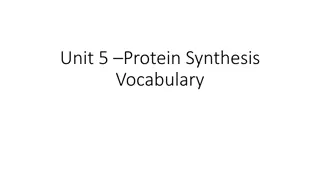Understanding Gene Translation: From RNA to Protein
Gene translation from RNA to protein involves the specific binding of transfer RNA molecules to messenger RNA codons, enabling the translation of nucleotide sequences into amino acids. Each amino acid is attached to a specific tRNA through activating enzymes, and the anticodon on tRNA pairs with the
0 views • 4 slides
Understanding Protein Synthesis Process
Explore the essential vocabulary related to protein synthesis, including RNA types like mRNA, rRNA, tRNA, amino acids, codons, and anticodons. Learn about the two key steps in protein synthesis - transcription and translation - and how they work together to create proteins in living cells.
0 views • 11 slides
Understanding Protein Synthesis and Translation Process
Proteins play a crucial role in various body structures and functions. The process of translation, as per the central dogma, involves converting genetic information from DNA to functional proteins through transcription and translation. This process includes initiation, elongation, and termination st
1 views • 25 slides
Understanding Genetic Foundations and Protein Production in Biochemistry
Exploring the genetic foundations of biochemistry reveals how organisms evolve through natural selection and how phenotype and genotype are interconnected. The process of gene expression plays a crucial role in determining an organism's phenotype. Additionally, protein production through translation
0 views • 17 slides
Decoding the Hidden Regulatory Codes Shaping Protein Evolution
The study explores the intricate relationship between genetic and regulatory codes that shape protein evolution. Discusses how duons, genomic footprints, and transcription factors densely populate and constrain protein-coding exons. Highlights how regulatory elements influence codon choice independe
0 views • 21 slides
Understanding Genes and the Genetic Code for Protein Synthesis
Explore the structures of genes, the degeneracy of the genetic code, and the process of protein synthesis through transcription, RNA processing, and translation. Delve into the role of exons, introns, promoters, and operators in gene expression in eukaryotic cells. Learn why the genetic code is dege
0 views • 13 slides
Understanding the Genetic Code and Protein Synthesis
Explore the fascinating world of nucleic acids, DNA, RNA, and the genetic code. Discover how the sequence of nucleotides in mRNA translates into amino acids, forming proteins. Learn about codons, ribonucleotides, and the triplet code, and unravel the process of reading the genetic code to determine
0 views • 20 slides
Understanding Translation in Genetic Processes
Translation is the process of converting RNA messages into amino acids in cells. This key step in gene expression involves decoding codons, utilizing tRNA as adaptors, and following the genetic code to produce proteins. The shared genetic code, the role of tRNA in carrying amino acids, and the conti
0 views • 10 slides
Deciphering the Genetic Code: Translation and Complexity
Translation, a key process in genetics, involves decoding the RNA alphabet into the language of proteins. This intricate process requires understanding codons, redundancies, and non-overlapping triplet codons. Early experiments by researchers like Marshall Nirenberg provided essential insights into
0 views • 22 slides
Understanding DNA, Transcription, and Translation Process
DNA carries genetic instructions in organisms through nucleotide sequences like A, T, C, and G arranged in a double helix. Transcription converts DNA to mRNA in the nucleus, where RNA polymerase copies the DNA template. mRNA, with U instead of T, carries the genetic message. Translation involves ami
0 views • 26 slides
Understanding Kinetic Proofreading in Biological Systems
Kinetic proofreading is a crucial mechanism by which the body accurately discriminates between closely-related molecules, such as mRNA codons and tRNA molecules in the process of protein synthesis. This process ensures that the correct molecules bind together, preventing errors that could have sever
0 views • 55 slides
Understanding the Central Dogma and Genetic Code in Botany
The central dogma in molecular biology explains the flow of genetic information from DNA to RNA to protein through transcription and translation. The genetic code is a set of rules translating nucleotide sequences into amino acids. It consists of codons that specify amino acids, with sense and signa
0 views • 23 slides











